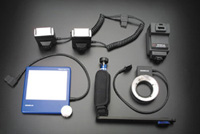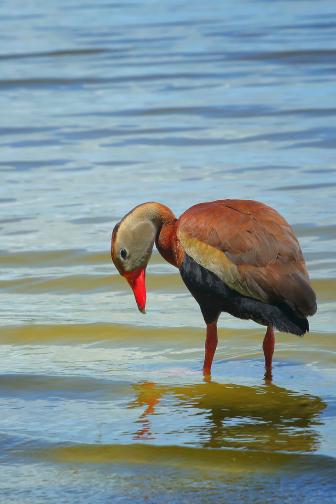Novoflex Macro Flash Lighting System
|
Macro photography seems to be in a golden age. Maybe it's the proliferation of digital point-and-shoot cameras with incredible macro focusing capabilities. Maybe it's the new breed of inexpensive macro zoom lenses, or maybe it's just a desire to reveal the beauty of items only possible in extreme close-ups. Regardless, dedicated macro photographers are usually focused nearly exclusively on lenses. It's the lens that gets you close, make no mistake. I routinely use 50mm f/2.8 and 100mm f/2.8 macro lenses on my EOS bodies, and to those I add a bevy of close-up filters, extension rings, and a Canon extension bellows. The really serious close-up shooters have always relied on Novoflex, the German manufacturer of lenses, tripods, ball heads, and all things macro. I've used Novoflex extension bellows and lenses for a number of assignments, always with stellar results. |
|||
One of my biggest problems when shooting extreme close-ups is lighting. While a gorgeous flower in late afternoon sunlight might not need much in the way of ancillary light, nearly every macro image will need a source of main or fill light. Your on-camera flash is almost useless when close-up, since it is sitting so far away from the lens. Tiny reflector cards and mirrors have always been favorites of macro photographers, but they rely on a main source of light to do their job. In my studio I shoot a lot of small detail shots for clients. I rely on the smallest softboxes I can find and dial my strobes down to 1/32 power. Even then I'm often faced with way too much light, since the softboxes are only a couple of inches away from the subject. For some shots I'll try my Profoto ringlight hooked up to a Balcar pack, but even at 1/32 power for macro work I'm at f/64 at ISO 100--just not practical with a 35mm or medium format camera. |
|||
These problems in mind, I jumped at the chance to review what I thought would be a new Novoflex ringlight unit. To my surprise, the box Novoflex shipped included not only the ringlight, but their two-head duo flash unit and a revolutionary new flat light panel called the LP-100 Light Panel. This is a formidable macro flash system, and it really is a true system. Central to the system is the flash generator unit. This looks like a small Sunpak swivel head flash, but with no flash tube installed. This unit houses the batteries and all electronics, and can be used in auto, manual, or true TTL modes with most popular cameras. You can plug in any of the flash heads to the generator and instantly create the kind of light that your shoot requires. |
|||
Ringlight Beauty |
|||
Duo Flash Setup |
|||
Ideal Macro Setup There is little not to like about this system. The individual components are not horribly expensive given this level of versatility. The flash generator lists for $239, the ringlight for $135, the duo flash heads for $160, and the amazing Flash Panel for $641. Surely there are cheaper units out there, but nothing that is as versatile and practical as this Novoflex system. Nothing is perfect of course: we wouldn't mind a little bit better construction on the flash generator and hot shoe modules, and the front mounted battery compartment is a bit difficult to access. That said, I'd buy this stuff in a heartbeat. If macro is your thing, then this is the kind of stuff that really should be in your camera bag. For more information, contact Novoflex, c/o HP Marketing Corporation, 16 Chapin Rd., Pine Brook, NJ 07058; (973) 808-9010; www.hpmarketingcorp.com. |






































